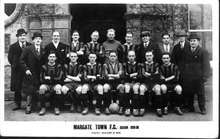Gerrit Keizer
.jpg)
Gerard Pieter (Gerrit) Keizer (August 8, 1910 – December 5, 1980), also known as Gerard Keyser, was a Dutch football goalkeeper. As well as being highly successful in his native country playing with AFC Ajax, he was also the original "Flying Dutchman" at Arsenal and contributed to their first league title in English football.[1][2]
Career
Keizer joined Ajax Amsterdam at the age of 16, and two years later made his debut for the side, against Stormvogels on April 1, 1929. For the first few years of his career he deputised for Ajax's No. 1 Jan de Boer, and in 1930 he made the move to England.
Keizer then first played as an amateur for Kent side Margate. At the time Margate acted as a "nursery" club of sorts for London giants Arsenal, and soon Keizer was spotted by Arsenal's manager, Herbert Chapman. Keizer was immediately pitched into the Arsenal first team, and played in Arsenal's first twelve First Division matches of the 1930-31 season, making his debut against Blackpool on August 30, 1930. He also played in the Gunners' Charity Shield victory over Sheffield Wednesday that season.[3] Arsenal won the match 2–1.[3]

Keizer's playing style was distinctly flamboyant, to the point of erratic; he truly lived up to the "crazy" stereotype of the goalkeeper. He never kept a clean sheet in his first-team matches at Arsenal, and with stiff competition from Arsenal's existing 'keepers, Bill Harper and Charlie Preedy, Keizer was dropped in October and never played for the first team again. He left Arsenal in July 1931 for Charlton Athletic, and later played for Queens Park Rangers as an amateur.
He finally returned to Amsterdam in 1933, and became Ajax's number one for the next fifteen years; he played 302 matches for the club, despite the Second World War intervening. He also played for the Dutch national side twice, his debut coming in a 1934 FIFA World Cup qualifier against Belgium, a 4-2 win that saw them reach the finals; Keizer did not make the squad for that tournament, however.
After the war, Ajax were in deep financial trouble and could not even afford their own kit. Keizer flew to London to ask his old club Arsenal for any help, and Arsenal obligingly donated a set of kit and some footballs. Ajax thus played their first matches after the war in Arsenal's red and white shirts, rather than their own. Keizer continued to make repeated trips across the Channel, but in 1947 he was discovered to be smuggling British banknotes amongst the sportswear; he was fined 30,000 guilders and sentenced to six months' imprisonment.
Personal Life
Afterward, Keizer got into business and went on to become one of Amsterdam's leading greengrocers. In 1955 he returned to Ajax, this time as a member of the club's board. He died in 1980 aged 70.
References
- ↑ "UEFA News - Arsenal's first 'Flying Dutchman". UEFA.com.
- ↑ Paul Simpson; Uli Hesse (7 November 2013). Who Invented the Stepover?: and other crucial football conundrums. Profile Books. pp. 102–. ISBN 978-1-84765-842-5.
- 1 2 "Fortune smiles on the Arsenal". Sheffield Independent. 8 October 1930. p. 10. Retrieved 22 March 2016 – via British Newspaper Archive.
External links
- Gerrit Keizer profile and stats at Wereld van Oranje (Dutch)